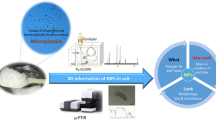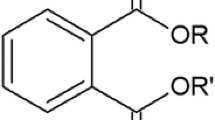Abstract
Zinc pyrithione (ZPT) is the antimicrobial substance and has been applied for various fields, including non-fouling coating paints and cosmetics. It also used for the tub part of the electronic machine with polypropylene (PP). Since the released ZPT can cause skeletal deformity or abnormality to coastal organisms, it is essential to quality check of ZPT in PP for environmental safety. However, as far as we knew, no previous reports about the analysis of ZPT in PP samples have been published; hence, we have developed a simple preparation method via extraction and precipitation. As assume that ZPT is just entrapped in the hydrocarbon chain of PP, ZPT was drawn out from the composites and homogeneously existed in the solution after untying the chain only precipitate PP with an organic solvent. This method could be applied for real manufactured samples with a low detection limit of 0.57 ppm within 10 min.








Similar content being viewed by others
References
Reeder, N.L., Xu, J., Youngquist, R.S., Schwartz, J.R., Rust, R.C. & Saunders, C.W. The antifungal mechanism of action of zinc pyrithione. Br. J. Dermatol.165, 9–12 (2011).
Yasokawa, D., Murata, S., Iwahashi, Y., Kitagawa, E., Kishi, K., Okumura, Y. & Iwahashi, H. DNA microarray analysis suggests that zinc pyrithione causes iron starvation to the yeast Saccharomyces cerevisiae. J. Biosci. Bioeng.109, 479–486 (2010).
Bragadin, M., Manente, S., Marton, D., Cima, F., Pia Rigobello, M. & Bindoli, A. The interaction of zinc pyrithione with mitochondria from rat liver and a study of the mechanism of inhibition of ATP synthesis. Appl. Organomet. Chem.17, 869–874 (2003).
Reeder, N.L., Kaplan, J., Xu, J., Youngquist, R.S., Wallace, J., Hu, P., Juhlin, K.D., Schwartz, J.R., Grant, R.A., Fieno, A., Nemeth, S., Reichling, T., Tiesman, J.P., Mills, T., Steinke, M., Wang, S.L. & Saunders, C.W. Zinc pyrithione inhibits yeast growth through copper influx and inactivation of iron-sulfur proteins. Antimicrob. Agents Chemother.55, 5753–5760 (2011).
Zhao, Y., Liu, Y., Sun, J., Sha, H., Yang, Y., Ye, Q., Yang, Q., Huang, B., Yu, Y. & Huang, H. Acute toxic responses of embryo- larval zebrafish to zinc pyrithione (ZPT) reveal embryological and developmental toxicity. Chemosphere205, 62–70 (2018).
Park, M., Cho, Y.-J., Lee, Y.W. & Jung, W.H. Understanding the mechanism of action of the anti-dandruff agent zinc pyrithione against Malassezia restricta. Sci. Rep.8, 1–11 (2018).
Nunes, B., Braga, M.R., Campos, J.C., Gomes, R., Ramos, A.S., Antunes, S.C. & Correia, A.T. Ecotoxicological effect of zinc pyrithione in the fresh-water fish Gambusia holbrooki. Ecotoxicology24, 1896–1905 (2015).
Cloyd, G.G., Wyman, M., Shadduck, J.A., Winrow, M.J. & Johnson, G.R. Ocular toxicity studies with zinc pyridinethione. Toxicol. Appl. Pharmacol.45, 771 (1978).
Snyder, D., Gralla, E., Coleman, G. & Wedig, J. Preliminary neurological evaluation of generalized weakness in zinc pyrithione-treated rats. Food Chem. Toxicol.15, 43–47 (1977).
Thomas, K.V. Determination of the antifouling agent zinc pyrithione in water samples by copper chelate formation and high-performance liquid chromatography atmospheric pressure chemical ionisation mass spectrometry. J. Chromatogr. A833, 105–109 (1999).
Nakajima, K., Yasuda, T. & Nakazawa, H. High-performance liquid-chromatographic determination of zinc pyrithione in antidandruff preparations based on copper chelate formation. J. Chromatogr.502, 379–384 (1990).
Kim, T.H., Jung, G.H., Lee, E.H., Park, H.R., Lee, J.K. & Kim, H.G. Development and validation of liquid chromatography-tandem mass spectrometry method for simultaneous determination of zinc pyrithione and pyrithione in shampoos. Acta Chromatogr.30, 200–205 (2018).
Das, S. & Khubdikar, K. A simple and facile spectrophotometric tool for quantification of zinc pyrithione (ZPT) in suspension. Chem. Data Collect.19, 100175 (2019).
Nguyen, N.L.T., Kim, E.J., Chang, S.-K. & Park, T.J. Sensitive detection of lead ions using sodium thiosulfate and surfactant-capped gold nanoparticles. BioChip J.10, 65–73 (2016).
Heo, N.S., Oh, S.Y., Ryu, M.Y., Baek, S.H., Park, T.J., Choi, C., Huh, Y.S. & Park, J.P. Affinity peptide-guided plasmonic biosensor for detection of noroviral protein and human norovirus. Biotechnol. Bioprocess Eng.24, 318–325 (2019).
Nakaoki, T. & Harada, S. Melting behavior of bound solvent in isotactic polypropylene/o-dichlorobenzene gel. Polym. J.37, 429–433 (2005).
Komjarova, I. & Blust, R. Comparison of liquid-liquid extraction, solid-phase extraction and co-precipitation preconcentration methods for the determination of cadmium, copper, nickel, lead and zinc in seawater. Anal. Chim. Acta576, 221–228 (2006).
Lide, D.R., CRC handbook of chemistry and physics, CRC press, 2004.
Reichardt, C. & Welton, T., Solvents and solvent effects in organic chemistry, John Wiley & Sons, 2011.
Ashkenazi, G. & Weaver, G.C. Using lecture demonstrations to promote the refinement of concepts: the case of teaching solvent miscibility. Chemistry Education Research and Practice8, 186–196 (2007).
Bagheri, R. Study of the effect of γ-absorbed dose on degradation of polypropylene/starch-filled polymer containing photo-initiators by spectroscopic methods. Radiat. Phys. Chem.78, 765–769 (2009).
Sakkas, V.A., Shibata, K., Yamaguchi, Y., Sugasawa, S. & Albanis, T. Aqueous phototransformation of zinc pyrithione — Degradation kinetics and byproduct identification by liquid chromatography-atmospheric pressure chemical ionisation mass spectrometry. J. Chromatogr. A1144, 175–182 (2007).
Shrivastava, A. & Gupta, V.B. Methods for the determination of limit of detection and limit of quantitation of the analytical methods. Chron. Young Sci.2, 21 (2011).
Black, J. & Howes, D. Toxicity of pyrithiones. Clin. Toxicol.13, 1–26 (1978).
Acknowledgements
This work was supported by the Basic Science Re-search Program through the National Research Foundation of Korea (NRF) funded by the Ministry of Science and ICT (NRF-2018R1A4 A1022647). It was further supported by the Chung-Ang University Graduate Research Scholarship in 2017.
Author information
Authors and Affiliations
Corresponding author
Ethics declarations
Conflict of Interests The authors declare no competing financial interests.
Rights and permissions
About this article
Cite this article
Park, C.Y., Moon, S., Baek, S.H. et al. Development of Detection Methods for Zinc Pyrithione in Polypropylene via Simple Extraction Methods for Quality Control. BioChip J 14, 211–217 (2020). https://doi.org/10.1007/s13206-020-4210-7
Received:
Accepted:
Published:
Issue Date:
DOI: https://doi.org/10.1007/s13206-020-4210-7




